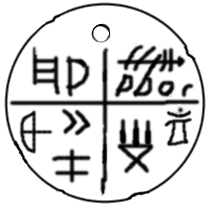Vinča symbols
The factual accuracy of this article is disputed. Please see the article's talk page for more information.
The Vinca alphabet is the suggested alphabet of Vinca culture.
Vinca alphabet
according to Pešić
In 1908, archaeological excavations began near Vinca, a suburb of Belgrade. Among other artifacts, excavations unearthed clay fragments bearing various marks. Later, more such fragments were found in Banjica, another part of Belgrade. To date, more than 1,000 fragments with inscriptions have been found on various archaeological sites throughout the Central and Eastern Balkans.

A clay vessel unearthed in Vinca, found at depth of 8.5 meters.
The inscription could be construed to read GULIU III (RTL).The importance of these findings lies in the fact that the oldest of them are dated around the beginning of the 6th millennium BC, almost 2,000 years before proto-Sumerian pictographic script, which is usually considered as the oldest script. The meanings of the signs were unknown until Dr. Radivoje Pešić from Belgrade noticed that all of the signs exist in Etruscan alphabet, and conversely, that all Etruscan letters are found among Vinca signs. Of course, the exact phonetic values of certain signs could not be known, but it is possible that they are similar to Etruscan ones.
Though it is usually accepted that these symbols are a script, some historians think that they are simply property marks.
If the signs are meaningless marks, then it could be expected that most of them do not exist in other alphabets; and that those that do are spread uniformly among them. But comparison with other scripts revealed that all marks of Vincan script exist in Etruscan alphabet, almost all in Phoenician alphabet, while there are few of them in other ancient scripts. For example, only two marks are found in Linear B, only four in Linear A or Runic alphabet, only twelve in Old Greek Alphabet.
If, as claimed, this is the origin of the Etruscan alphabet, then it means that the Etruscan alphabet is not derived from the Greek alphabet, as previously suspected due to the extreme similarity of the letters. Further, since different symbols in Vinca correspond to the Phoenician and Etruscan 'A', for example, it would mean that the Etruscan 'A' was not derived from the Phoenician 'A'.
If the signs are meaningless property marks, there would be a large variety of them. But the signs are stable and the same set of signs is found on the whole territory of Vinca culture, on locations hundreds of kilometers and years away of each other.
Of course, it is possible that some Vincans have used the marks as property marks while not knowing their meaning, in a similar way as today illiterate people are signing with X.
It is saddening that, while there is a reasonable grasp of the alphabet, not a single text written in this alphabet is known to us. Possibly the only exception is a stone found near Sitovo in Bulgaria, the dating of which is disputed; regardless, the stone has only around 50 marks. It is unknown which language used the script.
Reference
- Radivoje Pešić, The Vincha Script (ISBN 86-7540-006-3)
External link
- Vinca script at omniglot.com, including a font

